Art World
These Artists Spent a Year on a Satirical Trump-Themed Road Trip. Here’s What They Learned
"We have had a lot of closet Trump supporters come up to us, from all walks of life."
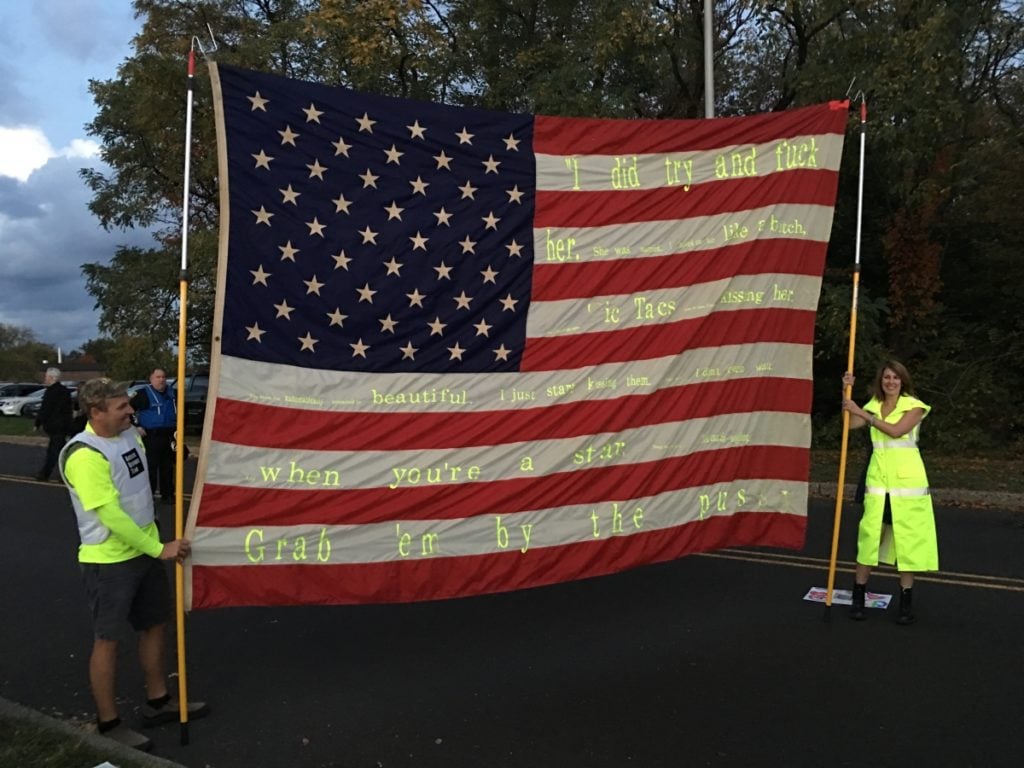
"We have had a lot of closet Trump supporters come up to us, from all walks of life."

For more than a year, artists David Gleeson and Mary Mihelic have been on a road trip into the heart of Trump Country. After the Iowa caucuses, they purchased a used Donald Trump campaign bus, remaking it as a satirical mobile art installation , dubbed the T.Rump Bus, criss-crossing the country hitting political rallies along the way.
Featuring works such as an American flag embroidered with Trump’s instantly infamous hot-mic quote from Access Hollywood, T.Rump Bus’s satire was not exactly subtle. Still, irony didn’t always play on the open road, and they’ve stirred the ire of all sides. At the same time, the nature of the project allowed them to talk to people who normally would simply tune out anti-Trump art.
Like the campaign itself, it has all come down to Florida for Gleeson and Mihelic, who go by the name T.rutt as a collective. Before the results for the election come in, and while the duo were waiting for AAA to replace their bus’s battery in Miami today, I talked to Gleeson and Mihelic about what they had learned about the state of politics in the country during their year-long voyage.
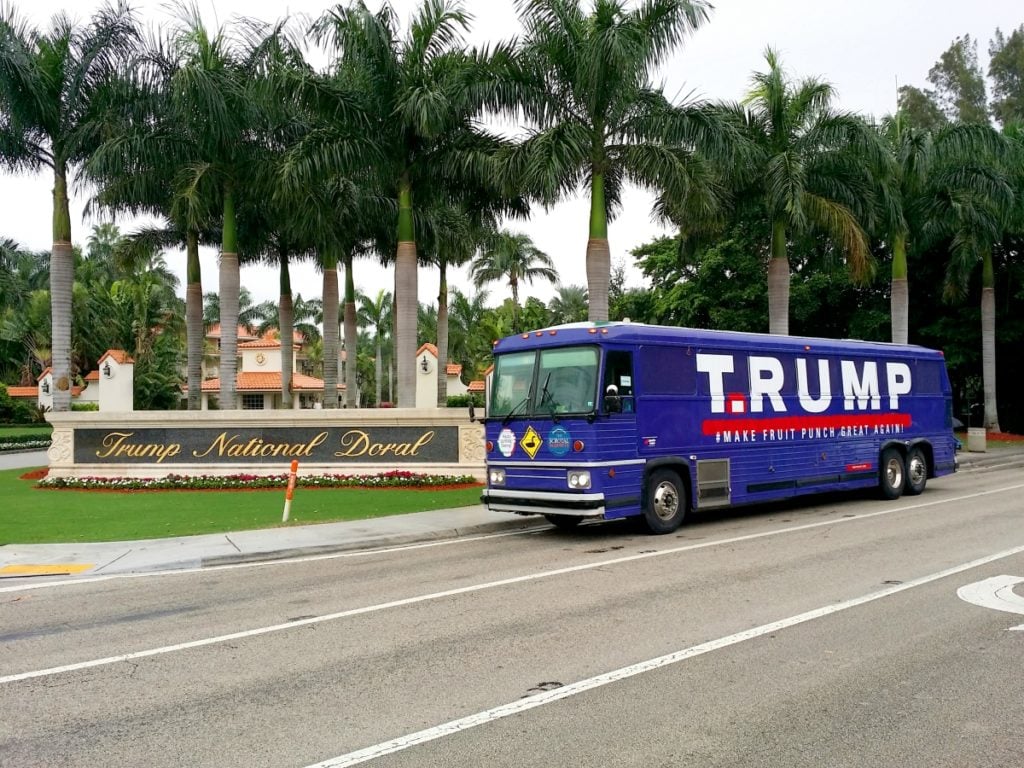
The T.rump bus outside of Trump country club in Coral Gables. Image courtesy T.rutt.
BEN DAVIS: The campaign has come down to Florida, and you’ve ended up in Florida yourselves.
DAVID GLEESON: We’re down in Miami Beach now, and for the first time, our banners were ripped off the bus last night, which was kind of sad. We’re going to have to do some repairs to keep it safe at night. But we’ve been having some great interactions. It’s been quite a journey.
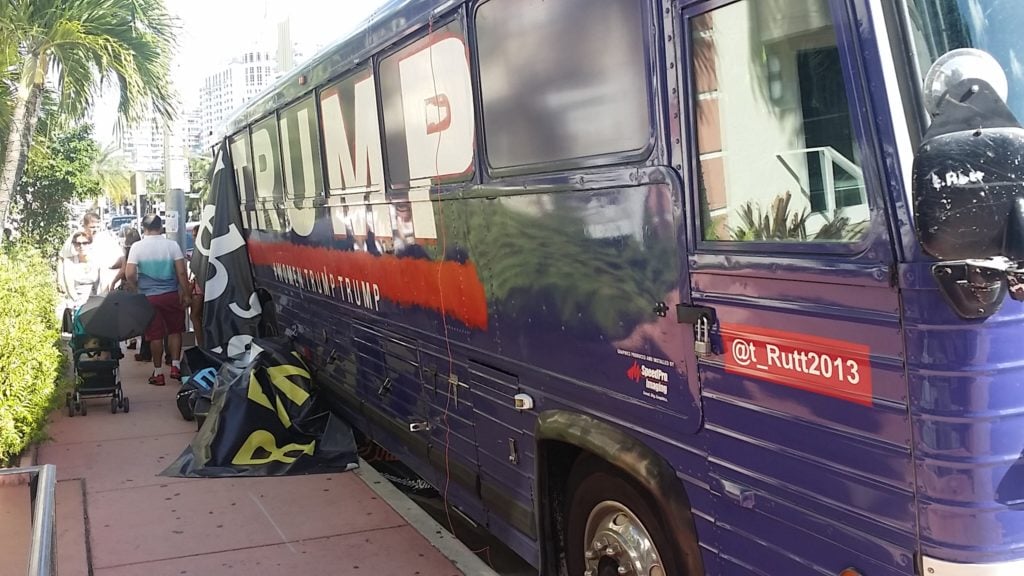
The banner on T.rump Bus, after it was pulled down in Miami. Image courtesy T.rutt.
MARY MIHELIC: Last October, when we first bought the bus, people thought we were crazy. We thought we’d be on the road for a month. In December and January, the reaction to the bus was kind of sleepy. People assumed Trump would be knocked out of the race. Now, the reaction has been magnified by about a billion times. People are so heated about Donald Trump, it’s unbelievable. We’ve gotten the finger probably thousands and thousands of times driving the bus.
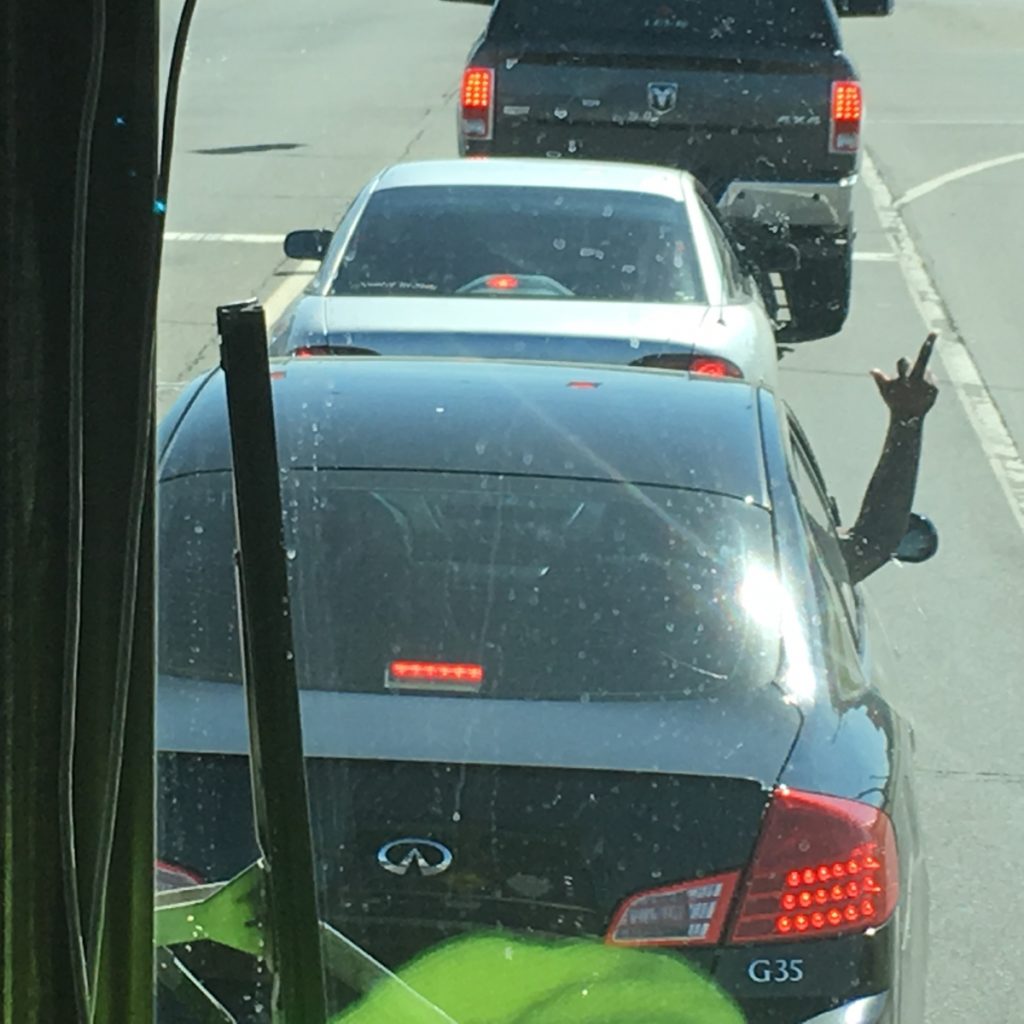
A reaction to the Trump bus from the road. Image courtesy T.rutt.
DAVIS: From both sides?
GLEESON: The first real big event we went to, at the beginning of this project, was a Hillary event in New Hampshire. We were all ready to see people excited to make fun of Trump. It was dark on a cold New Hampshire winter night, and the Hillary people were calling us Nazis and fascists.
MIHELIC: We were so naïve. We went expecting a big love fest, but they hated us at the Hillary rally. Yesterday, we were outside in the Lincoln Mall area in Miami, and we didn’t know that we were parked in front of the Hillary people. They called the police to have the bus towed. The police came down and told them, “You realize that this is an anti-Trump bus, right?” and they called it off.
GLEESON: In Newtown, Pennsylvania, we pulled into the Trump rally and everyone cheered. Everyone thought it was a pro-Trump bus. Then they started to get it, and things got heated. It’s an emotional flip. People who take just a few seconds to pause and think about it usually are pretty amused by the irony of it—unless they are are particularly extreme in their views.
DAVIS: What are some of the incidents that stand out in your mind?
MIHELIC: There have been so many. Early on, Berlin, Maryland, was pretty great in a way. We pulled in and there were thousands of people there, including a sizable anti-Trump protest. More and more people started showing up, so that the state police had to be brought in. Then they brought in riot police, because so many people were going at it.
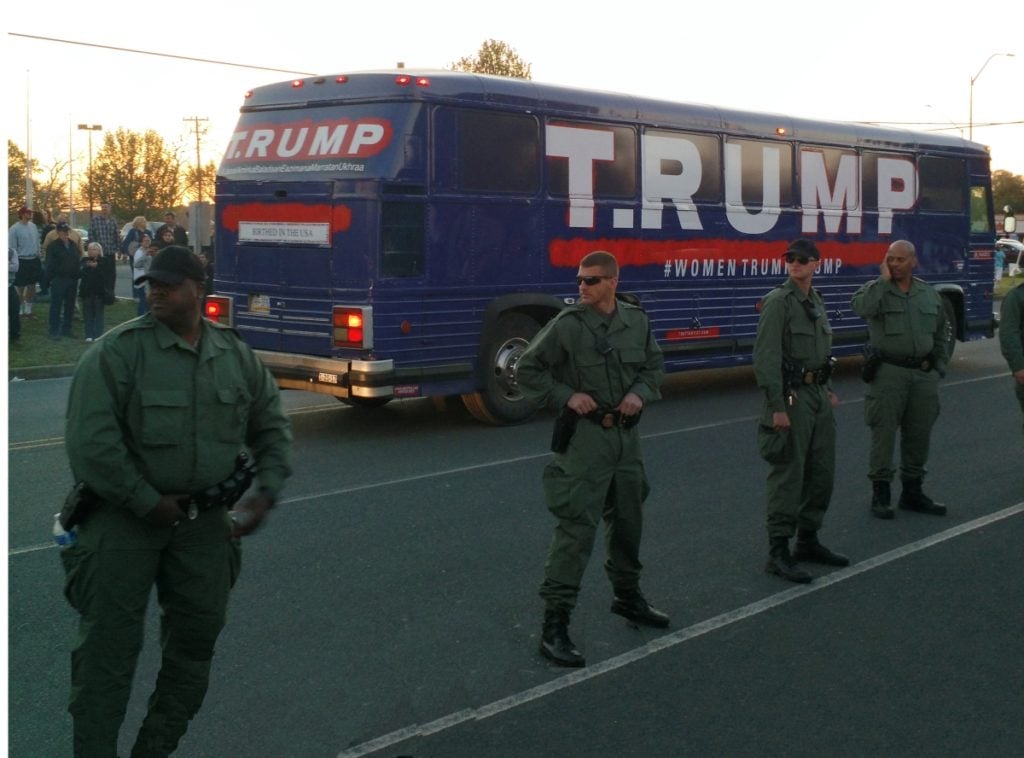
State troopers. Image courtesy T.rutt.
GLEESON: As it got hotter and hotter, the authorities moved the different groups to opposite sides of the street.
MIHELIC: But they didn’t shut the road, so riot police were lined up on one side, in front of the protesters, and on the other side, in front of the Trumpers. They are yelling across the street to each other. There was a block of people on each side, but they hadn’t closed the road. So David and I looked at each other and said, “Let’s drive the bus down the middle.” Both sides started cheering for the wrong thing! They both misunderstood the bus, and then everyone got it—and then everyone started laughing. It was awesome.
GLEESON: It was one of our better moments, to see that we could get such a divided crowd. To be able to get both sides to laugh together was really great. That’s part of the point.
MIHELIC: We’ve been yelled at so many times, it is great to see people laugh. The other night we went to the early voting and stood outside with our flag [the US flag embroidered with Trump’s Access Hollywood quote]. We opened it up, standing outside of the early voting station and got all kinds of reactions. We’d talk about how it’s a symbol, how the flag is a symbol and the office of the Presidency is a symbol. People would yell at me, “Don’t put that on the flag!” I’d yell back, “Don’t put that in the White House!”
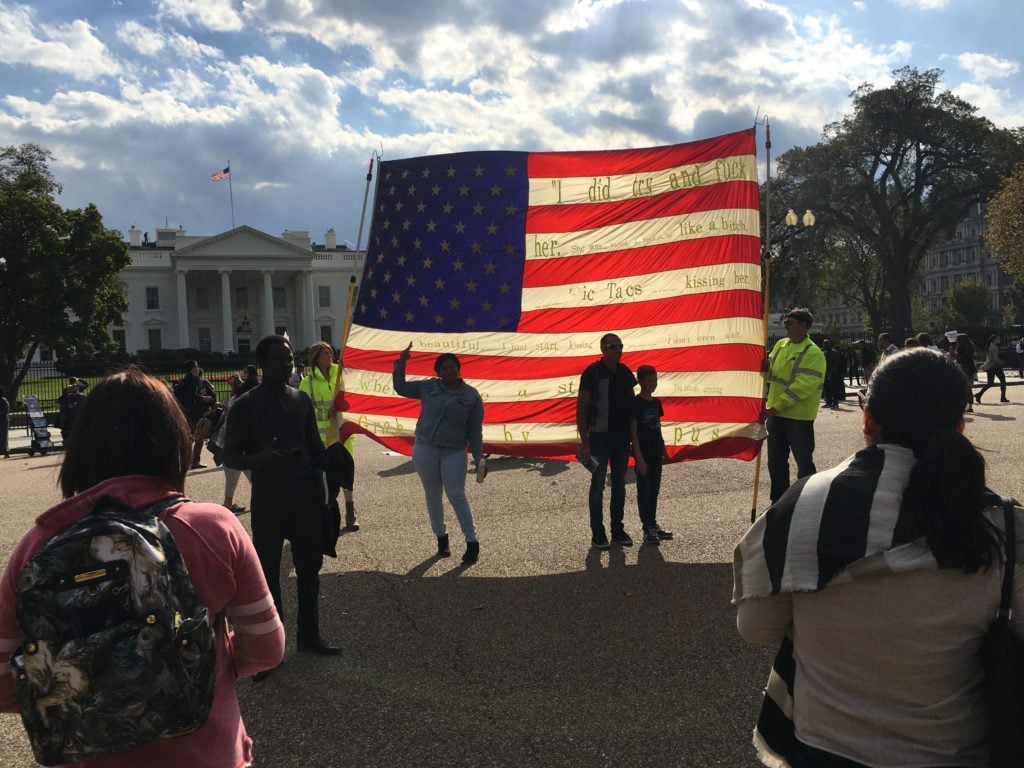
T.rutt’s American flag embroidered with Trump’s quote, on display outside the White House. Image courtesy T.rutt.
GLEESON: Something similar happened when we were in DC, outside a Trump rally, a crazy rally with so many protesters, more than we’ve ever seen. CWA, the communication workers’ union, had a big event there. We just showed up unannounced in front of the Trump International Hotel.
MIHELIC: We opened up the flag there. And one woman just started screaming, going crazy. Another woman loved our flag, and a full fight erupted right in front of us. It was unbelievable.
DAVIS: That’s the opposite of the other story. You brought them together before, and here you are tearing them apart.
MIHELIC: It’s actually harder for us at Hillary events than at Trump events. Because we really confuse the Hillary people. We drove by the Barack Obama event in Gainesville, North Carolina. There, we didn’t even feel safe parking the bus; it was way too heated. Somebody threw a Sprite bottle at us. Then people started to get it, and laugh, and say, “That’s really smart.” But still, we didn’t feel safe leaving the bus there.
DAVIS: It’s one thing to make political art that stays in a gallery or in a very constrained space. You’ve actually gone across the country talking to people. Has that changed the way you think?
GLEESON: You do see how Trump’s support is economic. The Republicans attack on social issues, and the Bible Belt has been a real manipulable population for them. But in Trump’s case, a lot of his support really seems to come from economic dislocation in these older industrial environments that have suffered.
MIHELIC: The country is a little scary right now. We were at one rally where we referred to the teenagers as the “Hitler Youth.” They surrounded us, chanting “get out!” They were really, really pushing at us. It scared me how powerful that mob mentality was. I was surprised. Again: I guess I was a little naïve.
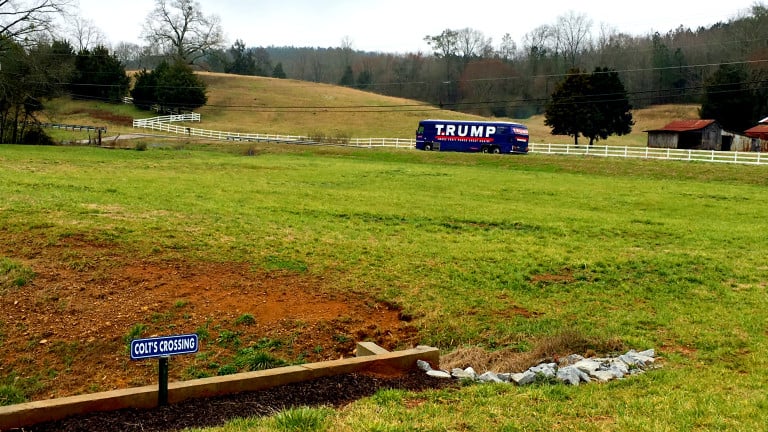
The Trump bus, on the road. Image courtesy T.rutt.
DAVIS: You’ve covered a lot of ground. Have you noticed differences in how people from the different camps have reacted in different places across the country?
GLEESON: People will come up and tell us that they voted for Trump or that they are planning to. Sometimes they will confess that to us, and then when they find out that the project is actually anti-Trump, they will start to hedge about whether they actually support him. Underneath that contradiction, there is a real desire for people to find a way to get along.
We have had a lot of closet Trump supporters come up to us, from all walks of life. We had a seemingly very well-off African American woman, driving a Lexus, a very professional woman. She was honking and giving the thumbs up, saying she’s a Trumper. Mary even had interactions with some naturalized citizens from Nigeria, who said they are definitely voting Trump.
MIHELIC: When we go to Trump rallies, they are the least diverse places on the planet. When we are out on the road, we’ve met the people who don’t go to the Trump rallies but are Trump supporters. That’s where we see some diversity. We don’t see any diversity at the rallies, ever.
DAVIS: I also just meant diversity in terms of how people are connecting to his message.
MIHELIC: If we pull into a Walmart parking lot or a post office, that’s a great place to really talk to people. There are these touch points. If a married woman who’s pro-Trump comes over, I will talk about his attitudes towards women. With war veterans, we’ll talk about his comments on waterboarding and torture, or they’ll look at the back of the bus where we have the text, “Save Water: Only Waterboard on Monday, Wednesday, and Friday.” They’ll always say that’s what they don’t like about Trump. But that doesn’t necessarily change how they’ll vote.
The conversation has changed over this year. After Cruz dropped out, the first thing we heard from everyone’s mouth was, “Oh, I don’t trust Hillary. Hillary is a liar.” I think people just used that as their excuse for why they were voting for Trump. Now, it’s changed again: People are much more open about it, about why they are voting for Trump. They’re not using her as an excuse anymore.
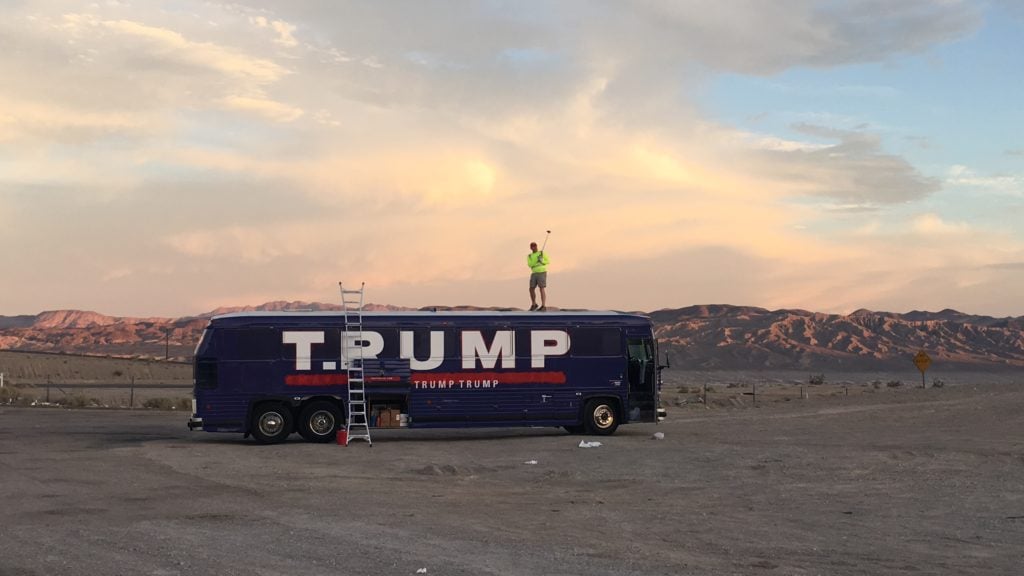
Playing golf in Death Valley. Image courtesy T.rutt.
DAVIS: What’s the most hostile place you’ve been?
MIHELIC: In L.A., someone tried to run us off the road. Twice.
GLEESON: A rally in Aston, Pennsylvania. Actually, Pennsylvania was tough in general. Being located in Philadelphia myself, I have to admit that. Pennsylvania is a tough state.
DAVIS: What’s been the place where people really got it?
GLEESON: Concord, Massachusetts.
MIHELIC: Tucson, Arizona! People were laughing and loving us in Tucson.
GLEESON: In non-political environments, it can go any way. In political environments, people are ready. But if we show up in a Walmart parking lot, and someone is just there, that’s where these emotional flips can be much more volatile.
MIHELIC: In L.A., we were outside a Walmart with the flags. People would see the bus, go inside, do their shopping and think about it, then come out to yell at me. Somebody said to me, “You’re going to look really beautiful when the Muslims come and you’re wrapped in a burqa.” Somebody else said, “This is all a lie. There’s no a way that Trump had anything to do with that bus.”
DAVIS: Do you think you’ve changed any minds?
MIHELIC: Yes. I do. Particularly with women. I’ll talk to women about his comments, and say, “Do you want a president who speaks like that?” And a lot of the women, particularly when we were in Ohio, would say, “I can’t vote for him because of what comes out of his mouth.” I found that to be interesting. A lot of the mothers and grandmothers are very affected by his language.
No one says directly that you changed their vote. They say, “I’m going to think about it.”
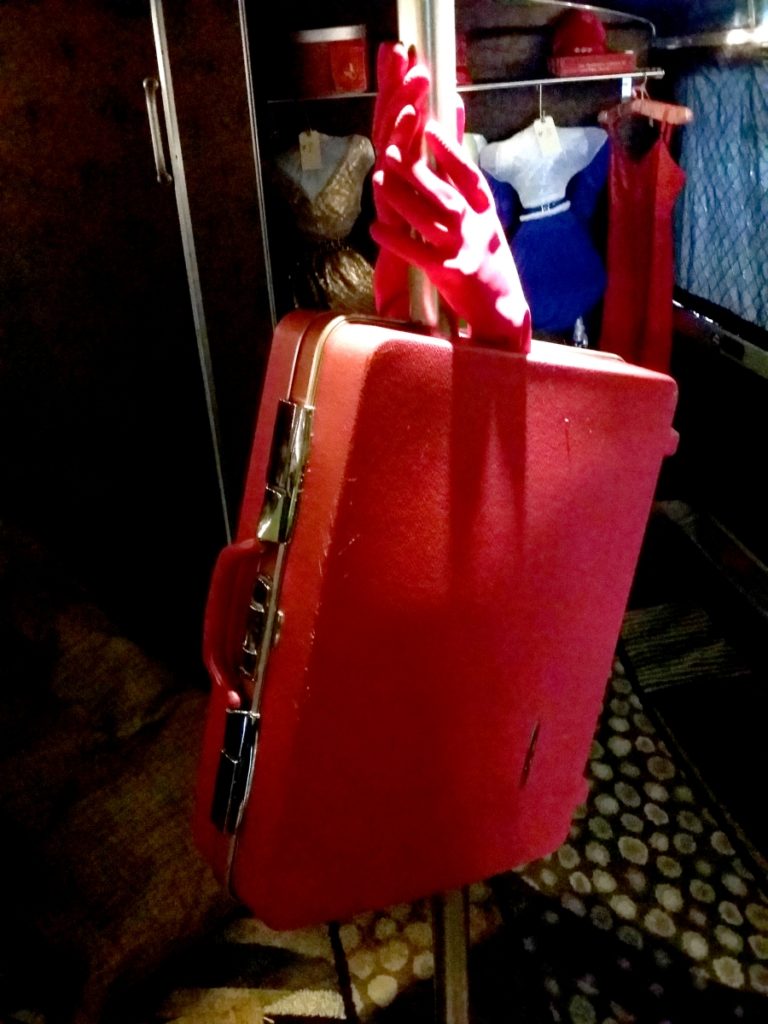
The (modified) stripper poll in the Trump bus. image courtesy T.rutt.
GLEESON: The stripper pole has been interesting to show. When they find out that there was a stripper pole in Trump’s bus, they get really offended. The bus was used for bachelor parties; it has reinforced tables for table dances. The Trump people leased it and updated it with all his graphics, without taking the stripper pole down. Some people see that and they say, “That’s just ridiculous.”
DAVIS: You’re at the end of your journey. What’s next for you?
MIHELIC: To me it will be relaxing. When all of the emotion is gone from the bus, it will be seen as history. We never know what we’ll be doing next, but it will be some kind of public protest art.
GLEESON: The emotion around the bus probably won’t drift away that quickly. The bus will be a relic. Or at least I hope it will be.